| |
"Power tends to corrupt, and absolute power corrupts absolutely. Great men are almost always bad men, even when they exercise influence and not authority, still more when you superadd the tendency or the certainty of corruption by authority." |
| |
John Emerich Edward Dalberg-Acton, April 1887 |
| |
Faustian Bargain: An agreement in which a person abandons his or her spiritual values or moral principles in order to obtain wealth or other benefits. |
| |
http://en.wiktionary.org/ |
History and literature is liberally peppered with warnings about the corrupting effects of power and the pursuit of untold wealth. The Bible assures us that "the love of money is the root of all evil" (New Testament – 1 Timothy 6:10) and Jesus himself is reported to have assured us that "it is easier for a camel to go through the eye of a needle than for a rich man to enter the kingdom of God" (Matthew 19:23-24). And yet educated people who claim allegiance to the Christian faith continue to lust after both money and power and preach to others the virtues of both. Some of them even get together to form political parties and then bullshit and propagandise their way into government, where they go on to prove the everlasting truth of Lord Acton's famous proclamation and legislate in favour of those for whom enough is never enough.
In its early forms as a Christian morality tale, the titular protagonist of oft-told German folktale Faust is searching not for wealth or power but unlimited knowledge and other worldly pleasures. That doesn't sound so bad, does it? What he does wrong is make a pact with the Devil to get what he desires, one that is set to revisit him later and bite him squarely in the proverbial arse. It's only later that the Faustian Bargain as defined above came into its own, with the Devil of times past transformed into a more metaphorical figure, a symbol of the corrupting lure of wealth and its seductive but superficial trappings. It's this that gives the story, the origins of which have been traced back to the 16th Century, its continuing appeal in a time when its religious overtones do not carry the weight they doubtless once did.
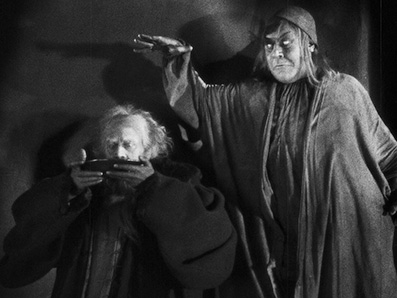
Over the years there have been a lot of film adaptations of the story and of the plays and the operas that it spawned. But as is so often the way, the first feature version is still the greatest, and by a considerable margin. We shouldn't be surprised. After all, its director F.W. Murnau was also responsible for the first and finest film adaptation of Dracula in the magnificent Nosferatu, eine Symphonie des Grauens. But stand the two films side by side and it's hard to believe they are separated by just four years, so dramatically had Murnau's cinematic skills and ambition developed by the time he made Faust, eine deutsche Volkssage [Faust, A German Folktale]. You might almost suspect that, frustrated by the restrictions of this relatively new medium in which he has chosen to work, he made a pact with the Devil to expand his knowledge and skills to the point where he had virtually no peer...
But I digress. Before I get carried away about one of the most astonishingly realised films of its time, I should probably point out that I've already explained the reasons for my enthusiastic admiration in some detail in my review of the previous Eureka! DVD release of the film, which you can read here. This re-release is a dual format edition that contains both Blu-ray and DVD versions of the film. So how does it differ from the previous release?
As with the earlier DVD, both the export version and the domestic print of the film have been included here – I covered the differences between them in my original review. As I noted there, the two prints differ markedly in quality, and that's all the more evident on the Blu-ray. To be honest, if you play the earlier DVD and the Blu-ray side by side, the export version looks almost exactly the same on both discs, which I presume is down to the condition and/or resolution of the source material. It has been transferred at 1080p, but for the most part looks like a standard definition transfer. Once again the image is remarkably clean for a film of this vintage, but it never displays the sort of sharpness and distinct detail you'll find on the Masters of Cinema Blu-ray version of Fritz Lang's Frau im Mond., to cite a recently released example.
But then the star of the show was always the rediscovered domestic version, which was, to quote my original review, was "reconstructed by Luciano Berriatúa for Filmoteca Española from nitrate dupe negatives printed by UFA in 1926 and a number of other international sources." This emphasis on the domestic print is reflected in the fact that the export version is listed as an extra feature here and occupies less than a quarter of the disc space of its reconstructed brother. It's not hard to see why. While on the DVD the difference in quality between the two versions was immediately apparent, here it is substantial, and the level of picture detail on the domestic print is visibly superior to the earlier SD release of the same. The contrast also appears to have been given a minor tweak, boosting the black levels and giving the picture a bolder look, but without sacrificing shadow detail (at one point, when Mephisto is in the dark shortly before he lights a lamp, I'd say the shadow detail is actually clearer). As you would expect, film grain that was only just detectable before is clearly visible, and the damage that remained on the earlier transfer is still present. This has clearly been sourced from the same restoration, but the extra resolution offered by Blu-ray really has made a difference. I'm not going to claim that the image is pin sharp, but it's still a considerable step up on the DVD release, and there are moments when the quality, cleanliness of the picture and even the level of detail (tree bark, for some reason, always looks terrific) really are quite startling. A very impressive job.
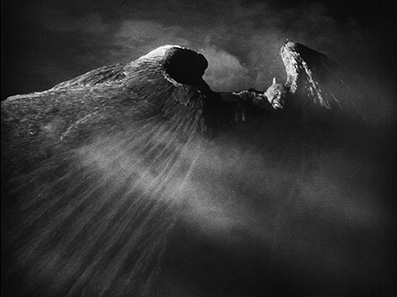
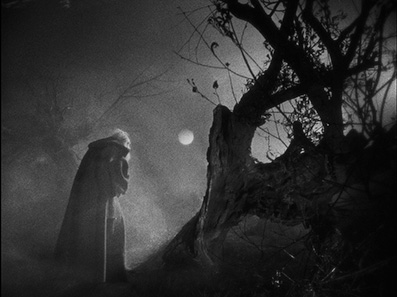
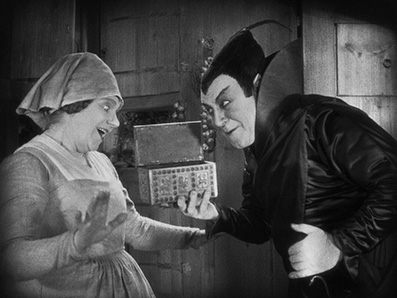
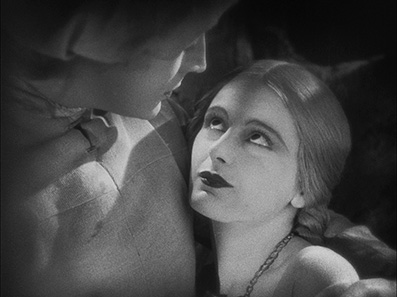
As before, you have the choice on the domestic print between the Timothy Brock orchestral score (my personal favourite) and the harp score by Stan Ambrose, both now in crystal clear Linear PCM stereo 2.0. But wait, what's this? This time around there's a third score on offer, a full blooded piano accompaniment by Javier Pérez de Azpeitia, also in Linear PCM stereo 2.0. Sonically, this sounds particularly good, particularly the bass notes, and the score as a whole has, dare I say it, a very 'silent movie' feel, the sort that might have been played along with the film when it originally screened. I liked this accompaniment a lot, and while I'm sticking with the Timothy Brock orchestral score as my favourite, this is only whisker behind.
Most (though not all) of the extra features have been ported over from the previous DVD edition, and some of the comments below have thus been adapted from that review.
Commentary on the Domestic Print
The commentary here is by critic and journalist David Ehrenstein and the US correspondent for Cahiers du cinéma Bill Krohn, the pair responsible for the highly informative and entertaining commentary on Eureka's now sadly deleted DVD of Nicholas Ray's The Savage Innocents. They clearly love the film (no arguments here) and really know their cinema history, citing a whole string of works influenced by Murnau and Faust in particular, including Fantasia (which they describe amusingly as "a much lesser work"), The Devils, Citizen Kane, The Ten Commandments, The Wizard of Oz and the works of James Whale and Terry Gilliam, to name but a few. It's a consistently interesting and enjoyable listen, and really does add to your appreciation of the film.
A Comparison of the Domestic and Export Releases (26:48)
A solid piece that usefully and clearly highlights some key differences between the two versions included on this release, including the framing of shots, the editing and – perhaps most startling in the pub scene – the very visible difference in clarity and detail.
Tony Rayns on Faust (39:24)
A gunsight-framed, monochrome interview with one of MoC's more regular contributors, though usually on their releases of Japanese films, which is Rayns' real area of expertise. There's not much to look at, but what is said is of considerable interest, as Rayns provides background on the evolution of the film, the influence of Max Reinhardt, information on Murnau himself, and even the reasons for shooting two versions at the same time.
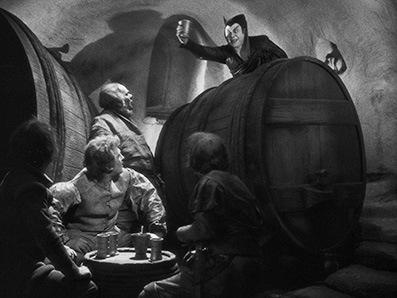
The Language of Shadows: Friedrich Wilhelm Murnau and His Films
– The Masterpiece: Faust (52:58)
New to this edition and seriously welcome is another in what we can presume were a series of documentaries on the director made for F.W. Murnau-Stiftung by Luciano Berriattúa. You can find the first on the Masters of Cinema Blu-ray of Nosferatu, and everything that made that one such an essential extra feature also goes for this equally informative and carefully assembled piece. The process of casting (Murnau originally wanted either Mary Philbin, Lillian Gish or Greta Garbo for the role of Gretchen, which eventually went to Camilla Horn) and designing the film is covered in detail, as is the filming of some of the more technically ambitious scenes. Relatives of those involved in the production are interviewed (including Murnau's niece Eva Diekmann and art director Robert Herlth's daughter Ellen Luckow), and quotes from actress Camilla Horn's autobiography reveal just what she was put through to achieve the level of authenticity that Murnau required. Particularly enthralling is the exploration of the different versions of the film, with multiple takes of the same shot or sequence placed on screen together for the purposes of comparison or analysis. Much of this is absolutely fascinating, with everything from small errors to small changes made by Murnau over the course of multiple takes examined in detail. And there's so much more than I've outlined here. A superb inclusion.
Booklet
Carried over from the booklet on the DVD edition is a detailed and informative essay on the film by Peter Spooner and a shorter but equally interesting piece on the multiple versions of the film by R. Dixon Smith. But this time there's more. New to this edition are excerpts from filmmaker and critic Éric Rohmer's seminal text on Murnau's film, The Organisation of Space in Murnau's Faust, which was written as a late-era doctoral thesis in 1972 and published in 1977. The introduction assures us that these extracts are "presented with the intention to give a 'taste' of Rohmer's treatment of Murnau more than anything else, as the comprehensiveness of the complete text cannot be distilled." Even so, the piece makes for fascinating reading and includes examples of Rohmer's own illustrations from his text, and certainly left me wanting to read the whole thesis. Also included are credits from the film, production stills and notes on viewing.
No qualms whatsoever about the upgrade here. Faust, eine deutsche Volkssage is one of my favourite Murnau films, and along with Der letzte Mann and Sunrise: A Song of Two Humans, one of his most visually and structurally ambitious and exciting. It's been eight years since the Masters of Cinema DVD release, and the improvement in picture quality on the HD upgrade of the domestic print is clearly visible on just about every shot. But this time around you also get the Javier Pérez de Azpeitia piano score, The Éric Rohmer piece on Murnau's organisation of space, and best of all, the superb Language of Shadows documentary on the film, marking this edition as a serious upgrade to the DVD. Highly recommended.
|